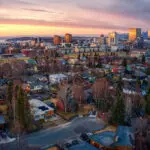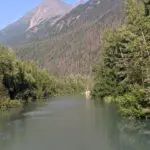Out of the fifty states, The Last Frontier, is large in size but not in people, yet it receives millions of visitors each year, and you’ll soon understand why. If you’ve ever wondered what Alaska is known for, this blog post is for you! Read on to find out what makes Anchorage and Alaska special.
Anchorage Annual Events
When most people think of Alaska, an image of Alaskan huskies racing through the snow-capped mountains in an expansive Alaskan terrain comes to mind. It’s no surprise that Alaska has held the iconic Iditarod Sled Dog Race for the past 50 years. Mushers, drivers of dog sleds, and sled dogs compete by completing a route that is a reconstruction of the famous route to Nome led by legendary Alaskan Leonhard Seppala, that saved a village of dying children. Many people are familiar with this heroic venture through the 1995 animation picture, Balto, and the 2019 Disney picture, Togo, on the sled dog hero and musher Leonhard Seppala, who traveled an impressive 264 miles during the harsh Alaskan winter to save thousands of lives during a deadly epidemic. Dog sled culture and Alaskan huskies are historically crucial to Alaska and its foundation. This iconic sporting event, held on the first Saturday of March, is a chance to experience it front and center.
Another iconic winter festival that makes Anchorage special is the Fur Rondy, which began in 1935. Back then, Anchorage consisted of just a few thousand people, and the winters were as harsh as ever. Leave it to Alaskans to get creative, and the Fur Rendezvous was born, the three-day celebration consisting of different games and activities to pass the time. Currently, it’s mostly known for its uniquely Alaskan competitions, such as running behind reindeer.
National Parks
Across the globe, the United States is world-renowned for its amount of natural parks. Any hardcore nature lover has Alaska on their travel bucket list for the most obvious reason. Location, location, location! Alaska is proudly home to an impressive eight national parks. That’s a whole lot of terrain to cover! With so many options, it’s easy to get overwhelmed. Luckily, you can pop over to the Alaska Public Lands Information Center in Anchorage to get a lay of the land before choosing an area to focus on.
Alaska deserves its nickname, The Last Frontier, as a significant chunk of land in Alaska is protected land, wild and raw. Each acre of protected land holds a piece of what makes Alaska unique compared to its 49 other counterparts. Alaska’s nature is like no other place in the world, making it truly special because of its untouched and unarguably breathtaking natural beauty from glaciers, snow-capped mountains, and sand dunes. A few top favorites – Denali National Park, Kenai Fjords National Park, and Wrangell St Elias National Park, are also within driving distance from Anchorage. Fun fact: more than half Kenai Fjords National Park is covered in ice.
Wildlife
The Last Frontier is unsurprisingly known for the “Big 5,” aka the five most prevalent species in Alaska, grizzly bears, moose, caribou, Dall sheep, and wolves. Although this would be enough for the average city dweller, wildlife enthusiasts will also delight over marine animals such as whales, otters, and sea lions. Grizzly bears made it in the “Big 5,” but Alaska is home to black bears and polar bears, too. If you’re eager to see bears in Alaska, plan your trip around the summer months as bears hibernate during the winter months.
There are plenty of moose roaming The Great Land, so you’ll likely spot one of these iconic creatures throughout Alaska, even in the city. Denali National Park, just a 4-hour drive from Anchorage, is a great place to spot caribou, as there are thousands throughout the park. Dall sheep are notoriously more difficult to spot as they live in the most rugged areas of Alaska and can spot humans from an incredible distance, making it hard to see them in the flesh. Count yourself lucky if you see them, as they are only found in Alaska and Canada! The undomesticated canine, AKA wolves, can be seen throughout Alaska but mainly reside in non-urbanized areas. Who hasn’t dreamt of witnessing a whale leap out of the ocean? If you’re guilty of this too, make sure to visit during the summer months, as this is the best time for whale watching. For more info on the best spots for wildlife viewing around Anchorage, check out our blog post.
History & Culture
In 1986, gold was discovered close to the Klondike River, which is actually part of Canada. Once the news traveled, thousands of people headed to the Yukon and Alaska with only one thing on their minds, gold, of course! As one could imagine, the journey was treacherous due to the harsh Alaskan winters, and many died along the way. A great place to get a gold blast from the past is Klondike Gold Rush National Historical Park. The park is located in former boomtown Skagway, Alaska, which is not only a cultural center rich with history but also offers hikes with stunning views of fjords, waterfalls, and lakes.
Alaska belonged to Russia for over a century, so it’s no surprise that traces of Alaska’s Russian roots still linger in Alaskan culture today. This can be seen in the small village of Sitka, a tiny port town in Southeast Alaska, home to three important Russian buildings: St. Michael’s Cathedral, a Russian Orthodox Church from 1948, the Russian Bishop’s House Museum as well as the Russian-American Building. Keep your eyes peeled for the onion domes, commonly seen in Russian Orthodox Churches as a signpost to Alaska’s Russian past. Aside from the Russian buildings that still stand today, Alaskans also devour traditional Russian eats such as piroshkis, pelmeni, and borscht.
Last but not least are Alaska’s Native Peoples, a large part of Alaska’s unique history and culture. There are five main groups of Alaska Native peoples, with 20 different cultures and a whopping 300 dialects. There are many ways to experience and learn about the rich culture of Alaska’s Native Peoples; from cultural centers, tours, and demonstrations to Alaska Native festivals and events, there is something for everyone. With so many different cultures and dialects, it’s easy to get overwhelmed! We recommend heading to the Alaska Native Heritage Center in Anchorage to learn more about Alaska Natives.
Ready for your Alaskan adventure? You can count on us to be your guide to authentic Anchorage food culture and to explore the amazing scenery and wildlife Alaska has to offer.







